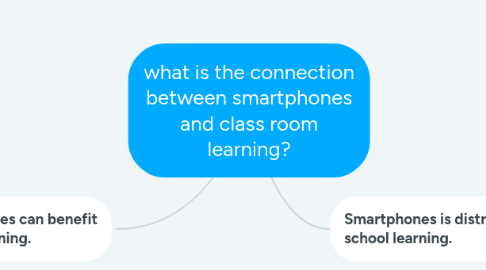
1. Smartphones is distracting school learning.
1.1. Smartphones offer several advantages in an educational setting, such as the electronic delivery of textbooks and other learning materials to students and linking classmates together with communication technology.
1.1.1. Using the most up-to-date equipment in school has always seemed to be a necessity.
1.1.1.1. Using the most up to date in the class room will help you find answers faster than with slow smart phones.
1.1.2. The cost and complication of traditional textbooks makes electronic delivery of course material straight into the hands of students a rather attractive proposition.
1.1.2.1. Using smart phones instead of text books is way easier to access to answers
1.2. . As demonstrated by the success of pilot programs, Soloway concludes, schools and educators must not resist but adopt smartphones in the classroom.
1.2.1. It is the device of choice by students—the kids themselves are bringing the devices to school
1.2.1.1. I feel like if kids could not bring there smart phones to school a lack of attendance would appear.
1.2.2. Kids are comfortable with the small keyboards; they have learned to thumb type.
1.2.2.1. Kids feel more comfortable with smaller devices because they probably can type faster and finish assignments faster.
1.3. because kids do not pay attention to school learning because there to busy playing on there phones
1.4. Because kids will get distracted and lose focus then they get a bad grade because they dont pay attention
2. Smartphones can benefit school learning.
2.1. Whether it's a smartphone, tablet or laptop, survey after survey shows more and more -- and younger and younger -- schoolchildren have their own computing devices and are taking them to class.
2.1.1. It gave out 5,600 laptops -- one to every pupil from Grades 3 to 11 -- starting in 2003.
2.1.1.1. They gave out 5,600 laptops from grades 3 to 11
2.1.2. Case in point: an abandoned $1.7-billion project to give every L.A.
2.1.2.1. $1.7 billion project to give every L.A school student an iPad.
2.2. But Sam Evans-Brown, of New Hampshire Public Radio, reports that starting a "bring your own device" rule comes with its own set of challenges.
2.2.1. Letting kids have their own devices means they can use technology for more than just special projects.
2.2.1.1. Letting kids know that devices can be used more than just playing games but can help plan agenda books and more.
2.2.2. One of the big things is engaging kids in the classroom.
2.2.2.1. Kids have to be able to use smartphones for not just games but to do school related home work and stuff

